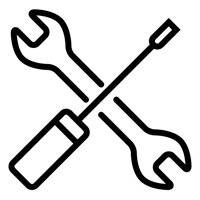The Complete Guide to Acoustic Imaging Cameras — How They Work, What They Detect, and Why It Matters
Author: James Osborne Date Posted:30 June 2025
Introduction: The Rise of Acoustic Imaging Technology in Industrial Diagnostics
In a world where uptime is critical and every second of equipment downtime can cost thousands, fast and accurate diagnostics have never been more important. Enter the acoustic imaging camera—a revolutionary tool that’s transforming industrial maintenance, asset management, and predictive diagnostics.
Unlike thermal cameras that detect heat signatures, acoustic imaging cameras use sound—specifically ultrasonic frequencies—to visualise problems invisible to the naked eye. This includes compressed air leaks, partial electrical discharges, vacuum leaks, gas escapes, and bearing faults. These devices translate ultrasonic sound into a real-time image, effectively "seeing" sound in the same way thermal cameras visualise heat.
At the forefront of this technology is HIKMICRO, a globally respected brand known for its high-performance thermal imaging and acoustic cameras. If you're exploring the world of ultrasonic detection, understanding how these cameras work and what they can detect is crucial to making the right investment for your operation.
In this guide, we’ll explore:
- How acoustic imaging cameras work
- What kinds of faults and issues they can detect
- Industrial applications across sectors
- The advantages of using HIKMICRO acoustic cameras
- How these tools fit into predictive maintenance strategies
- And why investing in this technology can significantly boost operational efficiency
Let’s dive in.
What is an Acoustic Imaging Camera?
An acoustic imaging camera, also known as an ultrasonic leak detector or ultrasonic imaging camera, is a specialised diagnostic tool that detects and localises sound waves—especially those in the ultrasonic range (above 20 kHz).
How It Works:
- Ultrasonic microphones arranged in an array detect high-frequency sound waves generated by leaks or mechanical issues.
- The camera’s onboard processor triangulates the source of the sound by comparing the arrival time of the wave to each microphone.
- The result is a real-time visual representation (often overlaid on a digital video feed), showing exactly where the sound is coming from.
This is known as beamforming—a signal processing technique that filters and locates the sound source by focusing on specific directions. The output is typically a colour-coded heat map, where hotter (brighter) zones represent stronger sound signatures.
Key Features of Modern Acoustic Cameras:
- High-microphone-count arrays (often 64+)
- Sensitivity to frequencies between 2 kHz and 100 kHz
- Integrated visual cameras for image overlay
- Touchscreen interfaces
- Real-time video capture with leak tagging
- AI-powered leak classification (in newer models like HIKMICRO)
These features make acoustic imaging cameras especially useful for non-contact, non-invasive diagnostics.
The Science Behind Ultrasonic Leak Detection
Leaks in compressed air, gas lines, or vacuum systems produce turbulent flow at the leak site. This turbulence generates broadband noise, with a strong component in the ultrasonic range.
Here’s why ultrasonic frequencies are ideal for detection:
- Directional: Ultrasonic sound doesn’t spread as widely as low-frequency sound. This helps pinpoint the source.
- Low Background Interference: Most environmental sounds are below 20 kHz, reducing false positives.
- Human-Safe: Acoustic imaging is completely non-destructive and doesn’t emit harmful radiation.
Moreover, electrical faults such as corona, arcing, and tracking also emit ultrasonic frequencies. Bearings, too, produce telltale ultrasonic signs as they wear.
This makes acoustic imaging a powerful multipurpose diagnostic tool.
What Can Acoustic Imaging Cameras Detect?
Acoustic cameras are used to detect a wide range of faults across various industries. Here are the most common and impactful use cases:
1. Compressed Air Leaks
Compressed air is often the most expensive utility in industrial settings—yet leaks go undetected for years. Acoustic cameras instantly identify even tiny leaks at long distances.
- Detects leaks even in noisy environments
- Locates leaks behind machinery or in hard-to-access areas
- Provides ROI by identifying cost-saving opportunities
2. Gas Leaks (Vacuum and Pressure)
Whether it's nitrogen, steam, CO2, or other industrial gases, leaks are a safety hazard and economic drain.
- Detects high-pressure and vacuum leaks
- Prevents product loss and health risks
- Complies with leak detection requirements in regulated industries
3. Electrical Partial Discharge
Corona, tracking, and arcing emit ultrasonic noise before they lead to failure.
- Diagnoses medium and high-voltage equipment
- Prevents catastrophic switchgear or transformer failures
- Ideal for substations, data centres, and electrical panels
4. Bearing Faults and Mechanical Wear
Acoustic cameras pick up the early stages of bearing failure by detecting subtle ultrasonic signals that thermal imaging cannot see.
- Identify lubrication issues
- Detect misalignment
- Predict equipment life cycles
5. Steam Traps
Faulty steam traps emit telltale ultrasonic signals. With acoustic imaging, you can detect traps stuck open or closed instantly—no contact required.
Industry Applications of Acoustic Imaging Cameras
Let’s break down where this technology is having the biggest impact:
1. Manufacturing Plants
In large production environments, compressed air usage is ubiquitous. Acoustic imaging allows engineers to:
- Survey the entire plant for leaks in hours
- Monitor energy usage more effectively
- Perform preventive maintenance without halting production
2. Oil & Gas Industry
Gas detection is crucial for both safety and operational continuity.
- Non-contact gas leak detection in high-risk areas
- Ideal for offshore rigs, refineries, and pipelines
- Complements infrared gas leak detection methods
3. Electrical Utilities
Partial discharge is a leading cause of unplanned electrical outages.
- Acoustic cameras allow for remote substation inspections
- Work during daytime and in all weather
- No need for personal protective equipment (PPE) when scanning from a safe distance
4. Food & Beverage Processing
Regulated industries such as food and beverage require leak-free air systems for pneumatic control.
- Locate hygiene-compromising leaks
- Prevent contamination from failing seals
- Audit compressed air system losses
5. Facilities Management
For hospitals, airports, and large commercial buildings, acoustic cameras help:
- Improve HVAC system performance
- Monitor compressed air and gas usage
- Maintain regulatory compliance
Why Choose HIKMICRO Acoustic Imaging Cameras?
HIKMICRO’s entrance into the acoustic imaging space brings advanced AI, affordability, and rugged design to the market. Here’s what sets them apart:
1. AI-Powered Leak Recognition
HIKMICRO’s acoustic cameras feature smart algorithms that:
- Automatically highlight and label leaks
- Estimate the leak rate (litres per minute)
- Calculate potential energy savings
2. High-Density Microphone Arrays
With up to 124 MEMS microphones, HIKMICRO cameras deliver:
- Pinpoint accuracy even in noisy environments
- High sensitivity to weak leaks
- Wide-area coverage without sacrificing resolution
3. Integrated Visual and Acoustic Overlay
See the leak and the surrounding context with precision:
- 5MP visible light camera
- Real-time acoustic overlays
- Easy image export for reporting
4. Touchscreen Interface and Intuitive UI
With a user-friendly design:
- Easy for technicians of all skill levels
- Real-time leak tagging
- Wireless transfer of inspection reports
5. Competitive Price-to-Performance Ratio
Compared to legacy brands, HIKMICRO cameras are often more accessible without sacrificing quality.
Predictive Maintenance with Acoustic Imaging
Predictive maintenance (PdM) relies on condition-based monitoring to detect early signs of wear or failure. Acoustic imaging is the perfect tool in this strategy.
How Acoustic Cameras Support PdM:
- Non-invasive, regular scans reduce unplanned downtime
- Early detection = proactive repair scheduling
- Reduces overtime, emergency repairs, and spare parts costs
PdM Use Case Example:
A manufacturer running 24/7 uses a HIKMICRO acoustic camera weekly to scan for air leaks and bearing faults. The early identification of two leaking valve seals prevented a complete shutdown, saving $85,000 in lost production and labor.
ROI and Energy Savings from Leak Detection
Compressed air and gas leaks can cost businesses thousands annually in lost energy. Here’s how using a HIKMICRO camera adds value:
|
Leak Size |
Energy Cost (per year) |
Detection with HIKMICRO |
|
1 mm |
$1,000 – $1,200 |
Instantly visualised |
|
3 mm |
$3,500 – $4,000 |
Measurable leak rate |
|
5 mm |
$8,000+ |
Documented for repair logs |
Detecting and fixing just 10 small leaks can pay back the cost of the camera within months.
Comparison: Acoustic Imaging vs Traditional Leak Detection
|
Method |
Pros |
Cons |
|
Soap & Water Spray |
Low cost, basic |
Time-consuming, not scalable |
|
Ultrasonic Leak Detectors |
Precise, portable |
No visual feedback, single-point only |
|
Thermal Imaging Cameras |
Great for hot gas leaks |
Useless for compressed air |
|
HIKMICRO Acoustic Cameras |
Visual + ultrasonic, real-time, AI-enabled |
Higher upfront cost |
How to Use a HIKMICRO Acoustic Imaging Camera
Step-by-Step:
- Power On – Turn on the camera and let it start up.
- Scan the Area – Sweep slowly across the target zone.
- Observe Heatmap – Watch for leak visualizations overlaid on the image.
- Tag the Leak – Use the UI to save images and log inspection notes.
- Generate a Report – Export the inspection data and images via USB or Wi-Fi.
Training and Safety Considerations
- Acoustic imaging cameras are safe for all environments, including high-voltage zones and explosive atmospheres.
- HIKMICRO offers training modules and manuals for proper use.
- New users can become proficient within hours, with minimal risk of misuse.
- Testrix Systems can offer training as part of the sales process.
Where to Buy HIKMICRO Acoustic Imaging Cameras in Australia
If you're looking to purchase a reliable, affordable, and advanced HIKMICRO acoustic imaging camera, look no further than Testrix—Australia’s trusted distributor of HIKMICRO diagnostic tools.
We offer:
- Expert advice
- After-sales support
- Training and usage guidance
- Fast shipping nationwide
Final Thoughts: Why It Matters
Acoustic imaging cameras are more than just the latest gadget in industrial diagnostics—they are essential tools for reducing energy loss, preventing breakdowns, and streamlining maintenance operations.
HIKMICRO’s range of acoustic cameras delivers on precision, usability, and return on investment.
Whether you're managing a manufacturing plant, a utility substation, or a commercial facility, investing in a HIKMICRO acoustic imaging camera gives you:
- Faster inspections
- Data-driven maintenance decisions
- Significant energy savings
- Enhanced workplace safety




